Table of Contents
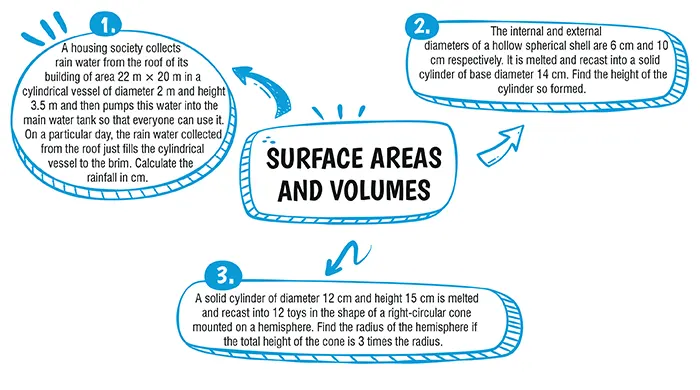
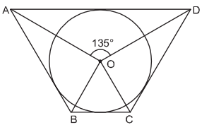
Ans.(b) 45°
Explanation:
Given, ∠AOD = 135°
∴ ∠BOC = 180° – 135° = 45°
Since, angles subtended at the center by a pair of opposite sides are supplementary.
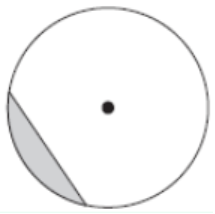
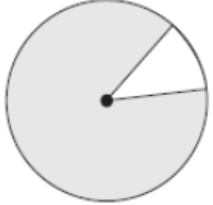

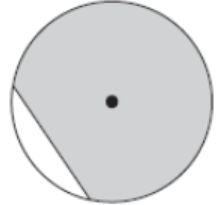
Ans. (a)
Explanation:
The shaded region consists of a chord and the arcs of the circle. The region in the white has the major arc, so it is the major segment and the shaded region consists of the minor arc, so it is the minor segment.
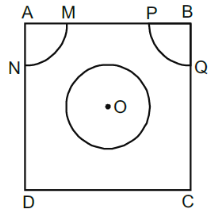
Explanation:
Given, AB = BC = CD = DA = 8 cm,
AM = AN = PB = QB = 1.4 cm and radius of circle with center O = 4.2 cm
Thus, area of the remaining portion
= Area of ABCD
- [Area of circle + 2 Area of quadrants]
\\= 8 × 8 - \bigg \{\dfrac{22}{7}(4.2)^2 + 2 × \dfrac{1}{4}× \dfrac{22}{7} (1.4)^2 \bigg\}\\
\text{= 64 - (55.44 + 3.08) cm}^2\\
\text{= 5.48 cm}^2
Explanation:
Given, length of the minute hand = r = 14 cm
Total number of divisions in the clock = 12
Hence the angle subtended at the center between two digits covering five minutes = \dfrac{360^o}{12}= 30^o\\
Hence, area swept by the minute hand in covering 5 minutes \\ = \dfrac{\theta}{360^o} \pi r^2 \\[5.5 bp]
= \dfrac{30^o}{360^o} × \dfrac{22}{7}× (14)^2\\[5.5 bp]
=\dfrac{154}{3} \\[5.5 bp]
= 51.33 cm^2.
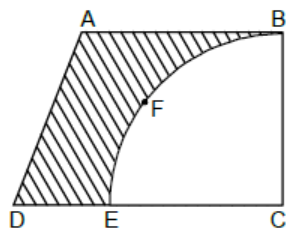
Explanation:
Given, AB =BC =3.5 cm and DE = 2 cm
As BC and EC are the radii of the circle, so
BC = EC
Thus, DC = (3.5+2) cm
= 5.5 cm
Hence , area of remaining part of the metal sheet
= Area of the trapezium - Area of the quadrant
= \dfrac{1}{2}× \text{(sum of parallel sides)}\\[4.5 bp] × \text{(distance between parallel sides )-} \dfrac{1}{4}\pi r^2 \\[4.5 bp]
= \dfrac{1}{2} (3.5 + 5.5)× 3.5 - \dfrac{1}{4} × \dfrac{22}{7} × (3.5)^2 \\[4.5 bp]= \dfrac{1}{2}× 9 × 3.5 - \dfrac{11×0.5×3.5}{2}\\[4.5 bp]= \dfrac{31.5}{2}-\dfrac{19.25}{2}\\[4.5 bp]
= \dfrac{12.25}{2}\\[4.5 bp]
= 6.125 \text{cm}^2
| Chapter No. | Chapter Name |
|---|---|
| Chapter 1 | Real Numbers |
| Chapter 2 | Polynomials |
| Chapter 3 | Pair of Linear Equations in Two Variable |
| Chapter 4 | Quadratic Equations |
| Chapter 5 | Arithmetic Progressions |
| Chapter 6 | Triangles |
| Chapter 7 | Coordinate Geometry |
| Chapter 8 | Introduction to Trigonometry |
| Chapter 9 | Some Applications of Trigonometry |
| Chapter 10 | Circles |
| Chapter 11 | Areas Related to Circle |
| Chapter 12 | Surface Areas and Volumes |
| Chapter 13 | Statistics |
| Chapter 14 | Probability |
| Chapter Wise Important Questions for CBSE Board Class 10 Maths |
|---|
| Real Numbers |
| Polynomials |
| Pair of Linear Equations in Two Variables |
| Quadratic Equations |
| Arithmetic Progressions |
| Triangles |
| Coordinate Geometry |
| Introduction to Trigonometry |
| Some Applications of Trigonometry |
| Circles |
| Areas Related to Circles |
| Surface Areas and Volumes |
| Statistics |
| Probability |
CBSE Important Questions Class 9
CBSE Important Questions Class 10
CBSE Important Questions Class 12
CBSE Practice Papers
CBSE Practice Papers
ICSE Important Questions Class 9
ICSE Important Questions Class 10
ICSE Practice Papers
ISC Important Questions Class 12
ISC Practice Papers
Contact Us
© Copyright 2024 oswal.io by OSWAL PUBLISHERS Simplifying Exams